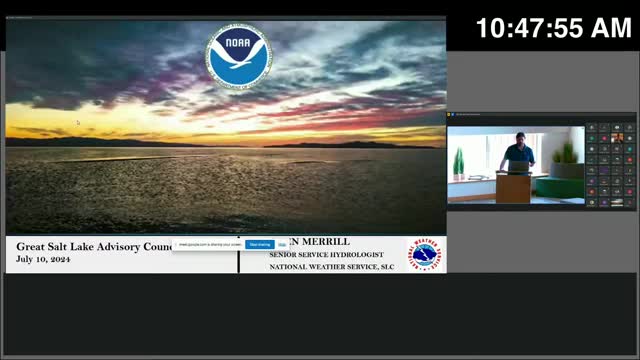Weather Patterns Boost Utah's Water Supply and Snowpack
July 11, 2024 | Great Salt Lake Advisory Council, Utah Division of Environmental Quality, Utah Government Divisions, Utah Legislative Branch, Utah

This article was created by AI summarizing key points discussed. AI makes mistakes, so for full details and context, please refer to the video of the full meeting. Please report any errors so we can fix them. Report an error »

In a recent government meeting focused on Utah's water supply and the impacts of weather on snow and water resources, officials provided an overview of the water year 2024, highlighting significant trends in snowpack and runoff that are crucial for the Great Salt Lake's health.
The discussion emphasized that 90 to 95% of Utah's water supply relies on snowmelt runoff, making the accumulation of snowpack during winter vital. This year, the state experienced above-normal temperatures, particularly in lower elevations, but the mountain regions maintained near-normal temperatures, which contributed to a healthy snowpack. The snowpack peaked in early April at 123% of normal, following a record-breaking winter in 2023.
Precipitation levels were also noteworthy, with many areas around the Great Salt Lake receiving above-normal rainfall, marking a significant improvement over previous years. The Bear River, Weber River, and Provo River basins reported efficient runoff, translating to increased water volumes reaching the Great Salt Lake. Reservoirs across the Wasatch Front are currently above 90% capacity, a positive sign following years of drought.
However, the meeting also addressed the challenges posed by a heat wave currently affecting the region, which could lead to increased evaporation and impact water levels in the Great Salt Lake. Forecasts indicate a potential shift towards the North American monsoon, which could bring additional precipitation to Northern Utah, although the outlook remains uncertain.
Looking ahead, the climate prediction center suggests that while temperatures are expected to remain above normal, there is a slight chance for increased precipitation as the monsoon season progresses. The discussion concluded with a note on the potential return of La Niña conditions, which historically have resulted in variable precipitation patterns for Utah.
Overall, the meeting underscored the importance of weather patterns in managing Utah's water resources and the ongoing efforts to prepare for future drought conditions while capitalizing on the current favorable water supply situation.
The discussion emphasized that 90 to 95% of Utah's water supply relies on snowmelt runoff, making the accumulation of snowpack during winter vital. This year, the state experienced above-normal temperatures, particularly in lower elevations, but the mountain regions maintained near-normal temperatures, which contributed to a healthy snowpack. The snowpack peaked in early April at 123% of normal, following a record-breaking winter in 2023.
Precipitation levels were also noteworthy, with many areas around the Great Salt Lake receiving above-normal rainfall, marking a significant improvement over previous years. The Bear River, Weber River, and Provo River basins reported efficient runoff, translating to increased water volumes reaching the Great Salt Lake. Reservoirs across the Wasatch Front are currently above 90% capacity, a positive sign following years of drought.
However, the meeting also addressed the challenges posed by a heat wave currently affecting the region, which could lead to increased evaporation and impact water levels in the Great Salt Lake. Forecasts indicate a potential shift towards the North American monsoon, which could bring additional precipitation to Northern Utah, although the outlook remains uncertain.
Looking ahead, the climate prediction center suggests that while temperatures are expected to remain above normal, there is a slight chance for increased precipitation as the monsoon season progresses. The discussion concluded with a note on the potential return of La Niña conditions, which historically have resulted in variable precipitation patterns for Utah.
Overall, the meeting underscored the importance of weather patterns in managing Utah's water resources and the ongoing efforts to prepare for future drought conditions while capitalizing on the current favorable water supply situation.
View full meeting
This article is based on a recent meeting—watch the full video and explore the complete transcript for deeper insights into the discussion.
View full meeting

